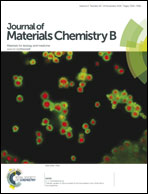Silica–PEG gel immobilization of mammalian cells†
Abstract
In this study, human foreskin fibroblasts and mouse embryonic fibroblasts were encapsulated in mechanically reversible, THEOS and THEOS–PEG gels that completely immobilized them restricting their motility, growth and proliferation. The changes in the membrane integrity and metabolic activity (MA) of the immobilized cells were measured by IR spectroscopy and fluorescence microscopy. To explore the effects of surface chemistry and porosity on immobilized cell MA, different amounts of a biocompatible polymer, polyethylene glycol PEG, was incorporated into the silica gels. To explore the effects of the proliferative stress, in selected experiments, cellular proliferation was arrested prior to immobilization by exposing the cells to irradiation. Four main factors were identified that affect the long-term survival of the cells within the immobilization matrix: (1) porosity/permeability of the gel, (2) structural homogeneity of the gel, (3) specific interactions between the cell membrane and the gel surface and (4) the proliferative stress. It was shown that the immobilized cells could easily be mechanically recovered from the gel and upon incubation, proliferated normally. It is believed that the gels and the matrix developed here have very significant potential applications in tissue engineering and in personalized cancer treatment.


 Please wait while we load your content...
Please wait while we load your content...